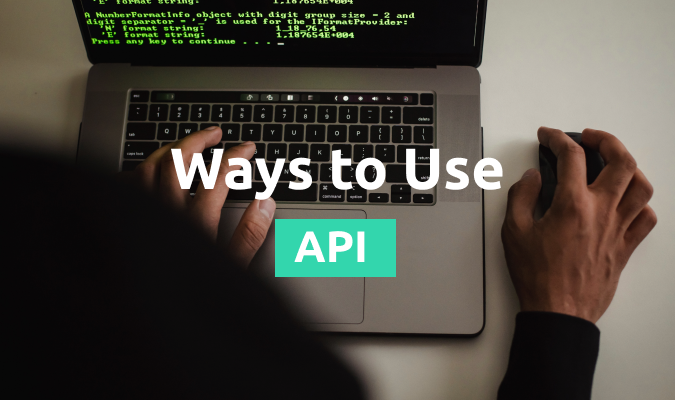Human beings interact through different mediums such as facial gestures, written words, or word of mouth. But have we ever considered how application software communicates?
Do you happen to know? Mobile applications and application software interact through a machine-readable software known as “Application Programming Interface(API).” Each time you search a place on Google map or listen to music via Pandora music or Spotify, you indirectly utilize an API.
In this article, we will reveal what APIs are and how developers use them. Let's take a good look!
What API is
Robert Munceanu from WebScrapingAPI describes- “Application Programming Interface (API)" as a set of functions that allows applications to access data and interact with external operating systems, software components, or micro-services.” In short, an API receives the user’s request and delivers it to the appropriate system or software. The result is that the software either accepts or rejects the user's request.
Typically, APIs contain what is known as the “function calls.” The function calls are statements that require the software to perform specific tasks and services for the user(s). They are phrases that comprise nouns and verbs. For instance:
- Shut down or sign out session on a computer.
- Power off or Reboot Session in a cell phone and many others.
Aside from what has been mentioned above, APIs serve other purposes. In most cases, software developers or programmers use APIs to amplify software development. For instance, if you create an app and wish to integrate it with weather snippets or facial recognition, API is the sure-fire way to achieve that. In this case, developers don't have to write source codes when integrating third-party providers like facial recognition. APIs make the job an easy ride. In other words, APIs serve as an excellent intermediary between two or more third-party systems.
How API Works
Consider an API to be the delivery agent of both the user and the latter’s application software. When you ask your app to perform a specific task, the app will redirect your request to the API. In any case, the API will tell your server what to do. These actions are called “a request.” After that, the server will respond and request that the “delivery agent” delivers its response to your application software.
Let’s look at a more realistic example. You walk into a pizza restaurant, pick a table with a great view and wait for the waiter to bring your order to your table. In this regard, the waiter is your API or “intermediary” because the chef cannot get your order at that point. You and your friends ordered a chicken pizza via the waiter, and the waiter notifies the kitchen about it. Then he gets a response and brings your order to the table.
How Developers Use APIs
There are many ways in which developers use APIs. However, the utilization of these APIs depends on the purpose in which they are built or their release policies. Let's look at the most familiar ways in which programmers use the APIs.
APIs Based on Release Policies
As far as release policies are concerned, developers can use APIs in three different ways. They can use it as private, public, and partner APIs. These categories are common in large organizations.
Private APIs
Developers utilize the private API functionalities within a particular organization. They integrate the APIs in the application software used by the employees inside the organization, enhancing the internal operation. In any case, only the members of the organization have absolute control over the API. In short, private APIs are for internal use.
Public APIs
Public APIs are the polar opposite of private APIs. Developers tailor the public APIs for everyone’s consumption. Unlike private APIs, there is no need to depend on any established relationships. The priority is to make access to the APIs easier and to draw many users closer.
Partner APIs
Due to its restrictive nature, a partner API is synonymous with a private API. It is because developers integrate the partner APIs in the application software used by one or more partners of your company. It involves a contractual agreement between the partner(s) and the API publisher (your company in this context). A partner API enhances the value of the services you offer and provides the opportunity for up-selling.
For instance, some ticket companies furnish a partner API to give their partners the remarkable ability to reserve event information.
APIs by Purpose
APIs may serve as intermediaries or a middleman or a delivery agent for users and various apps. However, they do that to achieve a specific purpose or goal. In this regard, developers designate these API categories based on what they want the users to accomplish. Let’s look at the most common categories of APIs by purpose.
Web APIs
A web API is the most common category in this regard. It delivers requests and responses from a web application using the Hypertext Transfer Protocol (HTTP). Developers adopt web APIs in their websites or application software to create a practical experience for the user. For instance, a web API involves including a login method via Instagram or Linkedin.
Operating System APIs
The operating system also utilizes an appreciable amount of APIs to provide information to the users. For instance, there are the windows API and Linux API. These functional system APIs will display prompts for users and perform other tasks that enhance user interaction with the software.
How Developers Use APIs to Shorten Links
There is always a period when a web developer will want to shorten a link or URL. One of the biggest reasons is to condense the link to create an excellent user experience. Another reason is to create customized links for businesses. In any case, most developers will channel the link shortening mechanism into creating API shortener links.
An API shortener link allows a programmer to collaborate with link shortening platforms and create web software. In this regard, we will identify prominent API shortener links.
Short.io
Short.io can save developers a lot of time. This service provides advanced features that let businesses get all the benefits of link shortening. The Short.io service connects internal operations with integrations for fast automation. In addition to reducing links, Short.io provides the ability to generate QR-codes for Google Chrome and Firefox.
Short.io Developer Hub
Use for freeBitly
Bitly will help the users to condense the links, track and share them. You can also customize your brand URL with Bitly.
Tiny
Tiny's API also helps users to make the links smaller. But what sets it apart from Bitly is that you can always access over eighty other platforms with a single short URL.
Rebrandly
Rebrandly is a link shortener that works like Bitly. You can create short links from scratch, track links and share them with other users.
VURL
What sets VURL apart from the API shorteners mentioned above is that it can collaborate with other services. It will help the developer to boost the capabilities of the link shortener.
In Conclusion
The growing numbers of application software for public and private use require exchange and communication channels. APIs fill that void and help to amplify business operations. It allows developers to send information to users, making it a veritable tool in today's world.
Developers tailor APIs to interact with users in ways that you may not even realize. You cannot get enough APIs from logging in to your social media app or finding local restaurants via Google Map APIs. Somehow, it is remarkable that you can harmonize APIs with link shortening services.
Author bio
Opal Miyamoto is a freelancer and a blogger from the United States. She also offers a dissertation service. She is very friendly and communicative. Opal is always open to new connections. Her hobbies are cooking, painting, traveling, and writing, of course.
What did you learn?
- how to shorten links with api
- free api for developers
- link shortener api
Read also:


